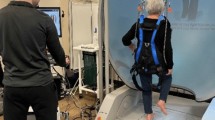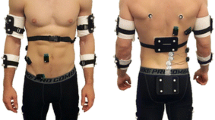Abstract
Although breathing perturbs balance, in healthy individuals little sway is detected in ground reaction forces because small movements of the spine and lower limbs compensate for the postural disturbance. When people have chronic low back pain (LBP), sway at the ground is increased, possibly as a result of reduced compensatory motion of the trunk. The aim of this study was to determine whether postural compensation for breathing is reduced during experimentally induced pain. Subjects stood on a force plate with eyes open, eyes closed, and while breathing with hypercapnoea before and after injection of hypertonic saline into the right lumbar longissimus muscle to induce LBP. Motion of the lumbar spine, pelvis, and lower limbs was measured with four inclinometers fixed over bony landmarks. During experimental pain, motion of the trunk in association with breathing was reduced. However, despite this reduction in motion, there was no increase in postural sway with breathing. These data suggest that increased body sway with breathing in people with chronic LBP is not simply because of reduced trunk movement, but instead, indicates changes in coordination by the central nervous system that are not replicated by experimental nociceptor stimulation.







Similar content being viewed by others
References
Arendt-Nielsen L, Graven-Nielsen T, Svarrer H, Svensson P (1996) The influence of low-back pain on muscle activity and coordination during gait: a clinical and experimental study. Pain 64:231–240
Bouisset S, Duchene JL (1994) Is body balance more perturbed by respiration in seating than in standing posture?. Neuroreport 5:957–960
Brumagne S, Cordo P, Lysens R, Verschueren S, Swinnen S (2000) The role of paraspinal muscle spindles in lumbosacral position sense in individuals with and without low-back pain. Spine 25:989–994
Byl NN, Sinnott PL (1991) Variations in balance and body sway in middle-aged adults. Subjects with healthy backs compared with subjects with low-back dysfunction. Spine 16:325–330
Caron O, Fontanari P, Cremieux J, Joulia F (2004) Effects of ventilation on body sway during human standing. Neurosci Lett 366:6–9
Chadha TS, Watson H, Birch S, Jenouri GA, Schneider AW, Cohn MA, Sackner MA (1982) Validation of respiratory inductive plethysmography using different calibration procedures. Am Rev Respir Dis 125:644–649
van Dieen JH, Selen LP, Cholewicki J (2003) Trunk muscle activation in low-back pain patients, an analysis of the literature. J Electromyogr Kinesiol 13:333–351
Gagey P, Toupet M (1997) The posture ventilation mystery: amplitude of postural sway in the 0.2-Hz frequency band. In: Gandevia SC, Allen GM, Butler JE, Taylor JL (1996) Supraspinal factors in human muscle fatigue: evidence for suboptimal output from the motor cortex. J Physiol 490(Pt 2):529–536
Gill KP, Callaghan MJ (1998) The measurement of lumbar proprioception in individuals with and without low-back pain. Spine 23:371–377
Grimstone SK, Hodges PW (2003) Impaired postural compensation for respiration in people with recurrent low-back pain. Exp Brain Res 151(2):218–224
Gurfinkel V, Elner A (1988) Neurophysiology 20:7–14
Gurfinkel VS, Kots Y, Paltsev E, Feldman A (1971) The compensation of respiratory disturbances of erect posture of man as an example of the organisation of interarticular interaction. In: Gurfinkel VS, Fomin SV, Tsetlin ML (eds) Models of the structural functional organisation of certain biological systems. MIT Press, Cambridge, MA, pp 382–395
Hamaoui A, Do M, Poupard L, Bouisset S (2002) Does respiration perturb body balance more in chronic low-back pain subjects than in healthy subjects? Clin Biomech (Bristol, Avon) 17:548–550
Hamaoui A, Do MC, Bouisset S (2004) Postural sway increase in low-back pain subjects is not related to reduced spine range of motion. Neurosci Lett 357:135–138
Hodges P, Moseley GL (2003) Pain and motor control of the lumbopelvic region: effect and possible mechanisms. J Electromyogr Kinesiol 13:361–370
Hodges PW, Gurfinkel VS, Brumagne S, Smith TC, Cordo PC (2002) Coexistence of stability and mobility in postural control: evidence from postural compensation for respiration. Exp Brain Res 144:293–302
Hodges PW, Moseley GL, Gabrielsson A, Gandevia SC (2003) Experimental muscle pain changes feedforward postural responses of the trunk muscles. Exp Brain Res 151:262–271
Hodges PW, Heijnen I, Gandevia SC (2001) Postural activity of the diaphragm is reduced in humans when respiratory demand increases. J Physiol 537:999–1008
Hodges PW, McKenzie DK, Heijnen I, Gandevia SC (2000) Reduced contribution of the diaphragm to postural control in patients with severe chronic airflow limitation. Proc Thoracic Soc Australia and New Zealand, Melbourne, Australia, 2000
Hunter W, Kearney R (1981) Respiratory components of human postural sway. Neurosci Lett 25:155–159
Kantor E, Poupard L, Le Bozec S, Bouisset S (2001) Does body stability depend on postural chain mobility or stability area? Neurosci Lett 308:128–132
Luoto S, Taimela S, Hurri H, Alaranta H (1999) Mechanisms explaining the association between low back trouble and deficits in information processing. A controlled study with follow-up. Spine 24:255–261
Moe-Nilssen R, Ljunggren AE, Torebjork E (1999) Dynamic adjustments of walking behavior dependent on noxious input in experimental low-back pain. Pain 83:477–485
Radebold A, Cholewicki J, Panjabi M, Patel T (2000) Muscle response pattern to sudden trunk loading in healthy individuals and in patients with chronic low-back pain. Spine 25:947–954
Radebold A, Cholewicki J, Polzhofer GK, Greene HS (2001) Impaired postural control of the lumbar spine is associated with delayed muscle response times in patients with chronic idiopathic low-back pain. Spine 26:724–730
Zedka M, Prochazka A, Knight B, Gillard D, Gauthier M (1999) Voluntary and reflex control of human back muscles during induced pain. J Physiol 520(Pt 2):591–604
Author information
Authors and Affiliations
Corresponding author
Rights and permissions
About this article
Cite this article
Smith, M., Coppieters, M.W. & Hodges, P.W. Effect of experimentally induced low back pain on postural sway with breathing. Exp Brain Res 166, 109–117 (2005). https://doi.org/10.1007/s00221-005-2352-4
Received:
Accepted:
Published:
Issue Date:
DOI: https://doi.org/10.1007/s00221-005-2352-4




